Accessibility on Campus
Where COA succeeds and falls behind, how this impacts our disabled peers, and what we can do to improve
What is the Problem?
College of the Atlantic (COA) is a small liberal-arts college in Bar Harbor, Maine. The campus is stunning, a cozy collection of buildings bordered on one side by Acadia National Park, and on the other by Frenchman Bay. COA's community is tight-knit—With only around 350-400 students and 35 faculty, we can pay attention to individual students in a way many larger institutions can't. I came to tour COA as a prospective student in 2019, and although the academic opportunities here had been the school's initial draw to me, what really sold COA in the end was getting to see our campus and our community in person.
For the past three academic years at COA I have been completing my work-study hours as a member of the campus's Buildings and Grounds department, and it was through this job that I began to notice something troubling. Those aesthetic elements of campus which had initially drawn me, an able-bodied person, in were actively pushing physically disabled people away. In conversations with my peers and supervisors I saw that it wasn't just me who had been thinking this. COA's campus is beautiful, yes, but it is also wildly inaccessible.
Improving access at COA is a complicated matter. Most of our buildings have been donated to the campus and have existed long before the Americans with Disabilities Act (ADA) was implemented in 1990. They were not designed with a college's needs in mind, let alone needs of access. In regards to pre-existing buildings, the ADA doesn't require schools schools to bring their buildings into ADA compliance, but if they do not, they may not offer programs that enroll disabled students in those buildings. This might have less of an effect at a larger institution where there are plenty of classroom and dorm spaces to choose from at any given moment, but because COA is so small, and because most of our buildings do not meet ADA standards, the impact on disabled people in our community is massive and can result in them being effectively cut off from the majority of our resources.
In order to address this issue, and to hopefully provide a basis upon which improvement can be made, I have taken a survey of campus in which I looked at the accessibility of campus's pathways and doorways.
The swipe map below displays aerial imagery of COA's campus and a map highlighting the various doors and pathways on campus. Doorways are identified via levels of accessibility, with green circles representing full access, yellow squares representing moderate access, and red triangles representing full inaccessibility. Campus paths are identified via difficulty of slope, with green lines representing easy slopes, yellow representing moderate slopes, and red representing difficult slopes.To compare the two displays, click and drag the two-arrows icon in the middle of the map from side to side. To view the map on a full screen, click the "expand" button in the top right corner.
Campus paths and doorways
Paths
COA's campus is on a slope, and although there is nothing to be done for our geography, there is certainly something to be done for material. Most of the pathways on COA's campus are made of gravel. Although this has a lovely aesthetic effect, the loose substrate means that attempting to navigate campus in a wheelchair is downright impossible. For the purposes of this survey I have created two different maps illustrating path difficulty which are represented by the swipe map below. The map on the left exclusively takes slope into account, whereas the map on the right considers both slope and material. On both maps, a green line represents an easy path, yellow represents a moderate path, and red represents a difficult path.
Campus path difficulty based on slope (left) and slope + material (right)
Doorways
The following three map tours offer a detailed look at points of accessibility and inaccessibility regarding the entryways and exits of campus buildings which are dedicated to general student and faculty use. There are ninety-six doorways included in this survey. Some buildings—such as the buildings and grounds shed and the hatchery shed by the Blair-Tyson dorms—have been excluded from this survey as they are not intended for general student and faculty use. To explore the map tours and see details on individual entryways and exits, click on one of the icons to the left of the map
Easy Access
There are only three doorways on campus which are fully and practically accessible. A fully accessible entryway is one that a disabled person can utilize completely independently and with no extra effort. These doorways meet the following criteria: There are no immediate obstructions in the doorway i.e., a ledge or step; the approach to the entryway is on a level plane or a gradual slope; the approach to the entryway is not typically obstructed by things like cars, bicycles, or used as a general storage space; and crucially, the doors can be opened automatically by electric activation switches.
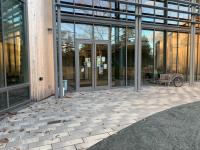
Davis Center for Human Ecology (CHE): North Door
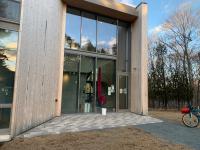
Davis Center for Human Ecology (CHE): South Door
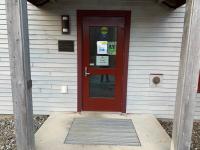
Deering Side Door
Moderate Access
Many of the doorways on campus are moderately accessible. This means that although the doorways may be technically accessible, they are not practically accessible. Doorways of moderate accessibility are ones that require some extra effort or assistance from another person to use. Extra effort in this instance takes many forms such as maneuvering over a small ledge or opening a heavy door by oneself. Although it may not occur to an able-bodied person that these kinds of obstacles can require extra effort, for a disabled person, something like a ledge or a heavy door can completely bar access. It cannot be assumed that all disabled persons will be able to easily or successfully make the extra effort required to utilize these doorways.
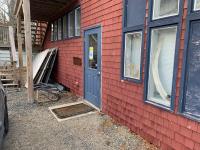
Studio 5 and 6
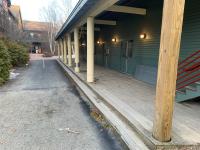
Gates
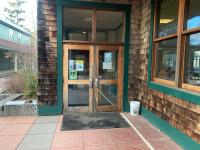
Take-A-Break (TAB)
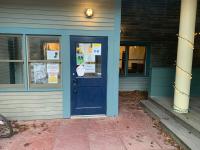
Arts and Science: Red Bricks Access
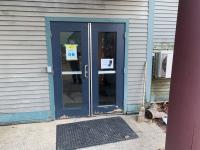
Arts and Science: Side Door
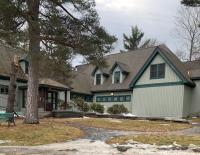
Dorr Museum
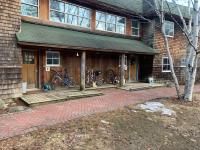
Blair-Tyson (BT)
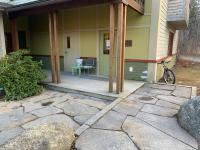
Kathryn W. Davis Village Dorms (The Village)
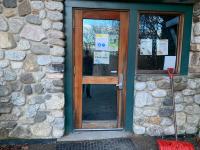
Free Box
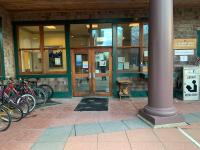
Thorndike Library and Admissions
Inaccessible
An overwhelming majority of the doorways on campus—sixty-one doors—are completely inaccessible. This means that the doorways are completely impossible to approach or use without specialized mobility aids meant for traversing difficult terrain, or significant assistance from an outside party or significant effort from the individual. This takes many forms for these doorways, including but not limited to: major staircases or ledges blocking the doorway and doorways having no dedicated accessible approach (a dedicated and regularly maintained path). Many of the buildings with completely inaccessible doorways do have moderately accessible doorways elsewhere, but the combination of moderate to complete inaccessibility can mean that disabled people may be completely barred entry from these spaces.
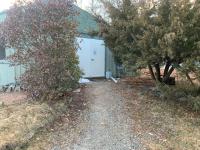
Ceramics Studio
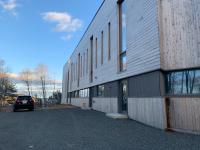
Davis Center For Human Ecology (CHE): Back Doors
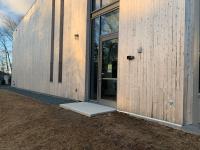
Davis Center For Human Ecology (CHE): Side Door
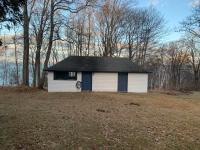
Office Space

Lecture Hall
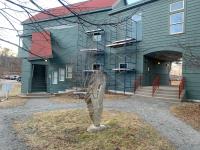
The Blum Gallery
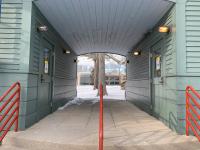
Arts and Science Breezeway
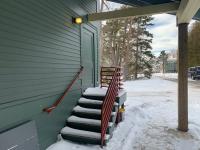
Gates Side Door
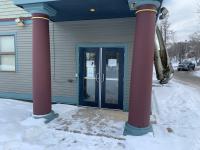
Arts and Science: Zoology Lab
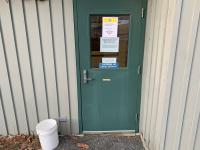
Dorr Museum: Back Doors and Classroom Entrance
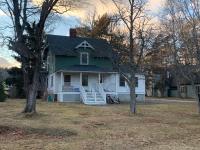
Cottage
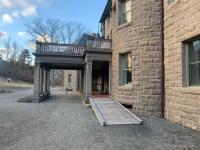
Turrets
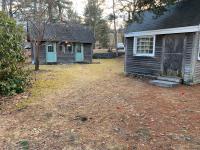
The Faculty Village
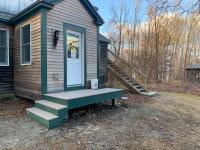
Peach
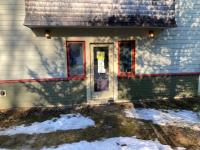
Kathryn W. Davis Village (The Village): Back Doors
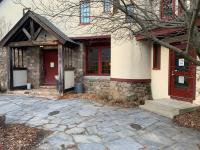
Deering
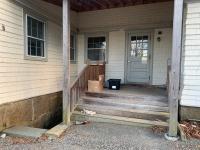
Seafox
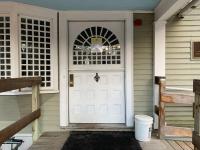
Davis
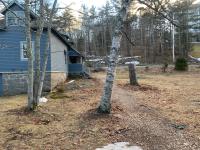
Carriage
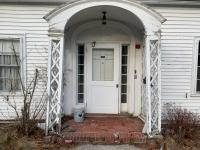
Witchcliff
Example Routes
In order to better understand how, when combined with one another, these design elements can pose a significant challenge to disabled people, let’s look at two example routes one might take across campus beginning at the green circle and ending at the red hexagon. The dotted line represents the route an able bodied person can take, and the solid line represents the route a disabled person might have to take. For these examples, it is assumed both individuals would want to take the most efficient and least challenging route to their destination. For the purposes of these examples it is also assumed that the disabled individual is relying on a mobility aid such as a wheelchair or power-scooter, and that they are not able to maneuver past obstacles such as uneven terrain or particularly steep slopes. Of course, this is not the case for all disabled people, but serves to demonstrate how certain forms of inaccessibility can severely impact one's ability to move around their environment.
To Tab
The map on the right illustrates the different routes that may be taken to Take-A-Break if one is leaving from the Miliken house in The Village. An able-bodied person would be able to cross the bridge in-between the village and Turrets, make their way past Turrets and up the stairs to their destination. This route is approximately 364 meters long. Meanwhile, a disabled person would not be able to use the bridge, as it is too narrow and is bordered on either side by a granite step. Instead, they would have to go up the road past Peach house, through the North Parking Lot, and then turn at the Blair-Tyson dorm to get back onto a path. From there they would be able to follow the path to their destination. This route is approximately 702 meters long, and requires one to travel through a parking lot. With a difference of 338 meters, the route a disabled person would have to take is nearly twice as long as one that their able-bodied peer could take.
To BT
Let's look at an example of a shorter route. This time, the map on the right illustrates the routes that may be taken to Blair-Tyson (BT) C if one is leaving from Turrets. An able-bodied person would be able to leave Turrets via the staircase and follow a path which is a near straight-shot to the dorm. This route is approximately 136 meters long. A disabled person would take the ramp down from Turrets and move through the Turrets parking lot, as the nearest path is too steep to reasonably use. Although there is a path along this road which could get to BT more efficiently, it cannot be used. This is because of an elevation difference between BT's brick pathway and the gravel path which leads to it*. Instead they must follow the road to its end in the North Parking Lot, and then must go to the only ramp leading onto the brick pathway of BT. This route is approximately 306 meters long. This route is over twice as long as the route an able-bodied person could take, largely due to the fact that the nearer side of BT's path is barred by an elevation change. Although it may seem a small detail, it has a significant impact.
*elevation change in paths at BT
From these examples we can see just how much of a difference inaccessibility makes. For disabled people on our campus, this is more than just a hypothetical, this is their reality. They are constantly having to do the mental math of figuring out which routes they can take and which routes are impossible. These differences in time or energy required to get somewhere have a butterfly-effect on every element disabled people's lives. The extra time required to get across campus adds up every time one has to relocate until people are having to sacrifice things like time for meals and rest, or energy and physical comfort just to ensure they don't fall behind. Minor details like an uneven path can make or break disabled people's capacity to go where they need or want to go. Beyond the physical and temporal consequences, making decisions in this way is just plain exhausting and can be overwhelmingly frustrating.
How Do We Improve?
The root of all needs of access, at COA and in our broader communities, is one that is tied deeply to disabled people's own sense of dignity and independence. In order to deepen my understanding of this issue, and to discuss potential ways in which COA can improve, I interviewed Silas Sifton--a current student at College of the Atlantic who identifies as physically disabled. Silas has used a wheelchair on campus, but due to navigating campus with a wheelchair being a logistical nightmare, they had to switch to using forearm crutches instead.
In Silas's case, their disability only began impacting them once they had already begun life at COA. As they elaborated on this, they said that if they had known how seriously their disability would have impacted them and how inaccessible campus would become to them, they would have gone to a different school altogether. Silas explained that to go from being able-bodied and not needing to rely on assistance from others to suddenly not being able to do things like go to the store without being in pain was a jarring shift, one which was only exacerbated by COA's lack of accessibility. As we talked, they described to me the emotional impacts that come with not being able to access campus in the same way their able-bodied peers can. "The fact that I can't really do things on my own [at COA]... I can't really put into words the perfect marriage of grief and humiliation that creates". And one of the most difficult parts of this shift was the loss of independence that came with it. They said they could no longer be certain that they could get into buildings like Turrets on their own, or make their way up hills without someone to push them.
Gravel paths on hills
It was impossible for Silas to remain independent on campus while using a wheelchair, so for the 202-22 school year, they have been using crutches. This has given them their independence back, but it has come at the cost of their physical wellbeing. They told me that this year they have had to make the decision to prioritize their independence over their health, but this method of living isn't sustainable. They worry that in order to stay at COA they will have to give up their independence again. Many if not all of the able-bodied people in COA's community would likely balk at the idea of having to choose between autonomy and academic achievement, without even realizing that our disabled peers are having to make this choice all the time.
"It's not a feeling of 'we don't want you here', but a feeling of 'we don't think you are here'"
Ramp leading to Davis's front door
Despite their frustrations and challenges with inaccessibility at COA, Silas is hopeful. Not is our newest building, the Davis Center for Human Ecology (CHE), very accessible, but it doesn't push access to the side. Silas says that accessible features in some other buildings such as elevators and electric doors, can feel out of the way and awkward to access. In contrast, CHE's front doors are both automatic ,and the elevator is not only efficient, but is centrally located and doesn't make Silas feel like they are losing time as they get around the building. Silas also reports that they have noticed a growing awareness amongst their able-bodied peers that COA is not accessible, people are beginning to really talk about making change on campus. Awareness, says Silas, is not the same as really understanding what its like to be disabled at COA, but it's forward growth, and that's been encouraging.
"The only way to eat a whale is one bite at a time"
I asked Silas what their hopes for accessibility improvement on campus were, and how they might see changes being implemented on campus. They told me that in order to really make a change for disabled people on campus, they feel there must be an intense hegemonic shift in the way able-bodied people at COA think about disability and access. Right now our conversations about the matter are grandiose, and although people seem to have the right spirit, their plans just aren't realistic for a small institution like COA to implement. Silas says that often at COA people can get caught up in what they call "big asks". Things like making sure that every door has an electric activation switch or paving every single path. Although these are goals that campus should be striving towards, they are incredibly large-scale, and will take a lot of time and effort to implement, leaving disabled people who are struggling now without any real support.
The Davis Center for Human Ecology, an encouraging step forward in accessibility at COA
Silas has a favored turn of phrase for matters like this one, "The only way to eat a whale is one bite at a time". We have to break the process of creating access on campus down into manageable pieces, and work towards the larger goal of full access. Talk is good, they explain, but action on a smaller, more individual scale will have a much more immediate positive effect while we work on the "bigger asks". "Before we build anything new, we have to fix what we have". They say that a massively helpful step could be providing threshold ramps at the doorways which are otherwise barred by ledges, bumps and steps. There's nothing to be done for the slope of campus, but the gravel can be addressed by way of paving our paths. Not all at once, but in phases over time--focusing on areas of heavy foot traffic and working out from there. Some classrooms just can't be reached, the classroom space on the second floor of turrets, for example. Silas says we don't need to abandon these spaces, but classes should be able to be moved to more accessible spaces if requested by a disabled student. It's okay, says Silas, for some dorms to not be accessible, but at the bare minimum there must be the option between substance and substance free dorm spaces which are fully outfitted to be accessible, and this wouldn't even necessarily mean building new housing, just adapting what we already have. Most of all, Silas says that disabled people must be involved in the planning process for these kinds of changes, both large and small things. They feel that this is COA's responsibility to the disabled members of our community, and I have to agree.
"It's a process, and I think that accepting and embracing that process, is the big paradigm shift I'm looking for."
COA is a fantastically unique college which draws people of vastly different backgrounds and life experiences together into an environment built upon camaraderie and caring. Nobody should be excluded from becoming part of our community because of an issue we could fix. I believe that accessibility on campus should be one of our top priorities as an institution, and I have seen how much people here care, both about reaching that goal and about COA itself. All we need now is a plan, and the willingness to try. We owe that much to our disabled fellows.